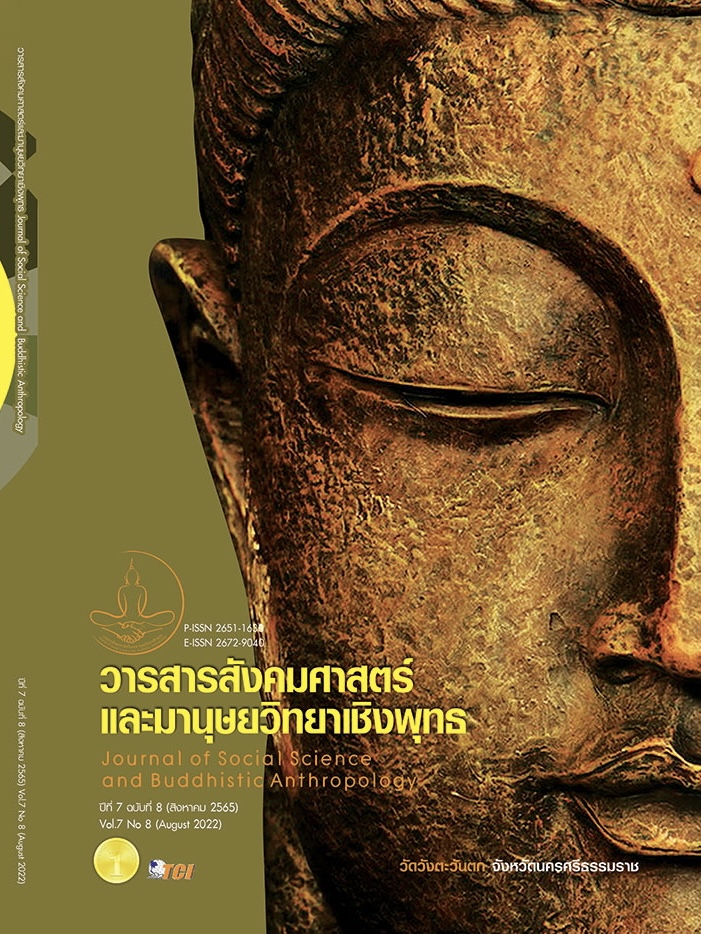HAND PUPPET SHOW DEVELOPS LANGUAGE RECOGNITION AND EXPRESSIONS SKILLS FOR MENTALLY IMPAIRED CHILD
Keywords:
Hand puppet show, Perception Skills, Language Expressions, Children With Mild Cognitive ImpairmentAbstract
The Objectives of this research article were to develop language recognition and expression skills with hand puppet theater activities of children with intellectual disabilities Minor level, aged between 6 - 8 years old and part of the thesis on Developing language perception and expression skills through hand puppet theater activities of children with intellectual disabilities low level, age between 6 - 8 years, sample population a child with intellectual disabilities Minor level, age between 6-8 years with IQ level 50 - 70, no redundant disabilities. Use a specific selection method. The research conducted consisted of the design of activities based on the following theoretical concepts: 1) the process of creating a puppet play 2) Theory of learning from models (Bandura) 3) 3R teaching theory for children with intellectual disabilities 4) Theories of learning from models (Bandura). SMCE Communication (Daid K.Berlo) The researcher designed the activities as follows: 1) Study the curriculum according to the Early Childhood Education Curriculum 2017, teaching methods, teaching and learning theory for children with intellectual disabilities; 3) Write a puppet show activity plan. 4) Bring the puppet theater activity plan to 3 experts to check the appropriateness of the content of the activity. It was found that the activity can be used. It consists of 3 steps, 10 minutes intro, 10 minutes in instruction, 10 minutes in summary, 24 sessions of the activity, 8 times a week, 3 times 40 minutes each, consisting of 1) personal information, 2) family information. and people around; 3) information about animals and animal voices; 4) language for communicating in daily life.
References
จิตราภรณ์ เตมียกุล. (2531). การศึกษาเปรียบเทียบสมรรถภาพในการฟังนิทานของเด็ก ปฐมวัยโดยการใช้รูปภาพและหุ่นมือประกอบ. ใน วิทยานิพนธ์การศึกษามหาบัณฑิต สาขาการศึกษาปฐมวัย. มหาวิทยาลัยศรีนครินทรวิโรฒ.
ชิตาพร เอี่ยมสะอาด. (2548). เด็กปฐมวัยกับทักษะทางภาษา. สุราษฎรธานี: คณะครุศาสตร์ มหาวิทยาลัยราชภัฎอุดรธานี.
ธนิดา จันทวงษ์. (2541). การวิเคราะห์เนื้อหาภาพยนตร์การ์ตูนหุ่นคนทางโทรทัศน์เพื่อการพัฒนาเด็ก. ใน วิทยานิพนธ์นิเทศศาสตรมหาบัณฑิต สาขานิเทศศสาตรพัฒนาการ. จุฬาลงกรณ์มหาวิทยาลัย.
นงลักษณ์ รักพงษ์. (2560). พัฒนาหุ่นมือและกิจกรรมเพื่อการสื่อสารความสามารถทางการพูดและการฟังของเด็กปฐมวัยโดยใช้กิจกรรมการเล่านิทานประกอบหุ่นมือ. ใน วิทยานิพนธ์การศึกษามหาบัณฑิต สาขาเทคโนโลยีการศึกษา. มหาวิทยาลัยบูรพา.
ผดุง อารยะวิญญ. (2539). แนวการจัดกิจกรรมการเรียนการสอนสำหรับเด็กที่มีความบกพร่อง. กรุงเทพมหานคร: แว่นแก้ว.
ลัดดา นีละมณี. (2531). นวัตกรรมหุ่นมือ. เรียกใช้เมื่อ 19 เมษายน 2564 จาก Wannipapu4.Blogpot.com.blogpost_08.
วรรณณี สิริสุนทร. (2532). เอกสารคำสอนอธิบายวิชาบรุ 620 การเล่านิทาน. กรุงเทพมหานคร: ภาพพิมพ์.
วรัญญา ศรีบัว. (2560). นิทานและหุ่นประกอบมือ. ใน วิทยานิพนธ์ครุศาสตรมหาบัณฑิต สาขาการศึกษาปฐมวัย. มหาวิทยาลัยราชภัฎอุดรธานี.
สาวิตรี เกษณี. (2560). การพัฒนาความสามารถในการอ่านโยการจัดการเรียนรู้แบบบูรณาการประสาทสัมผัสร่วมกับการสอนแบบ 3R ของนักเรียนที่มีความบกพร่องทางสติปัญญา. ใน วิทยานิพนธ์ครุศาสตรมหาบัณฑิต สาขาหลักสูตรและการสอน. มหาวิทยาลัยราชภัฏพิบูลสงคราม.
Green, S. T. (2016). Puppets in Educatio. เรียกใช้เมื่อ 17 เมษายน 2564 จาก www.thepuppetsafetysquad.com
Kandinsky, K. T. (1988). Point and Line to plane. New York: Dover Publication.
Downloads
Published
How to Cite
Issue
Section
License
Copyright (c) 2022 Journal of Social Science and Buddhistic Anthropology

This work is licensed under a Creative Commons Attribution-NonCommercial-NoDerivatives 4.0 International License.








